
Introduction
Biomedical waste includes infectious, pathological, chemical, pharmaceutical, radioactive, and sharps waste produced during healthcare activities.
Why BMW management is critical:
-
Prevents hospital-acquired infections (HAIs)
-
Reduces transmission of HIV, HBV, HCV from sharps injuries
-
Prevents contamination of soil, air, and water
-
Complies with national and international regulations
-
Reduces legal liability for hospitals
-
Ensures the safety of:
-
Healthcare workers
-
Waste-handling staff
-
Scavengers
-
General public
-
Environment
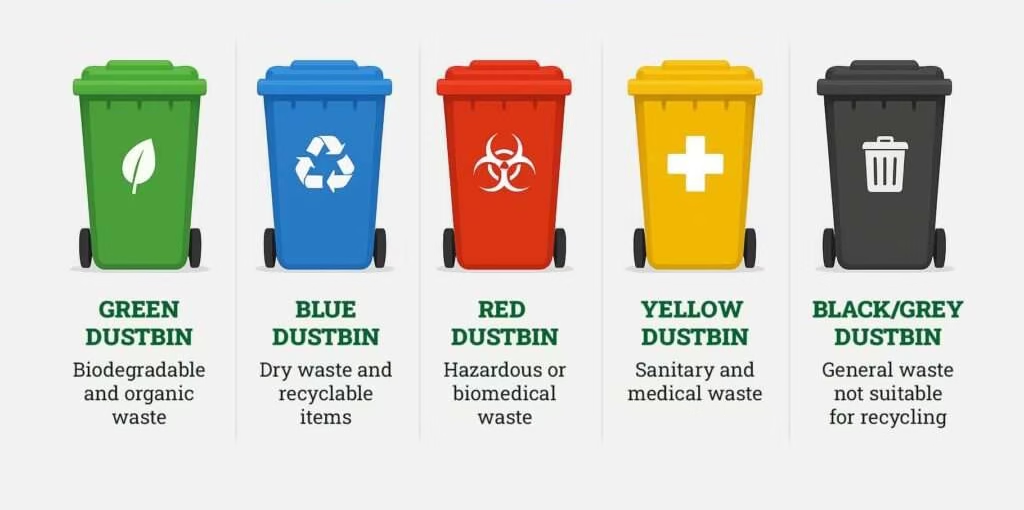
-
Global Context:
-
WHO estimates 15–20% of healthcare waste is hazardous, but improper segregation makes up to 70% hazardous.
-
Developing countries face challenges due to inadequate treatment facilities.
Classification of Biomedical Waste
- Biomedical waste management in India, as governed by the Biomedical Waste Management Rules (BMWM), 2016 and amendments (2018, 2019, 2023), mandates a standardized color-coded segregation system for safe collection, storage, transport, treatment, and disposal of healthcare-generated waste.
- The six-color system ensures minimal cross-contamination, worker safety, reduced environmental toxicity, and efficient downstream processing.
1. Yellow Category – Incineration / Deep Burial / Autoclaving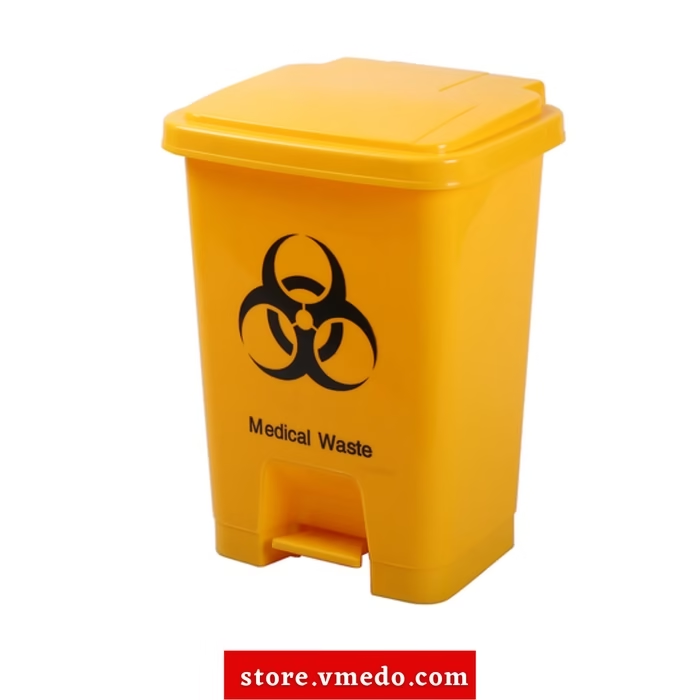
Purpose:
Destruction of infectious, pathological, and anatomical waste that contains high microbial load and poses a risk of infection and environmental contamination.
What Goes Into Yellow Bags/Containers:
A. Human Anatomical Waste
-
- Tissues, organs, limbs
- Placenta, umbilical cord, fetus (≤24 weeks as per guidelines)
B. Animal Waste (from research labs, vets, animal houses)
-
- Carcasses, body parts, tissues, organs
C. Soiled Waste
-
- Blood-soaked cotton, gauze, dressings, swabs
- Bandages, plaster casts with blood/body fluids
- Materials contaminated with pus, sputum (e.g., TB wards)
D. Expired or Discarded Medicines
-
- Antibiotics, cytotoxic drugs (non-genotoxic)
- Ampoules, vials without sharps
E. Microbiology and Biotechnology Waste
-
- Cultures, stocks, sample plates, broths
- Autoclaved and disinfected microbiology waste (though some states require red bags after autoclaving)
Treatment & Disposal:
-
- Incineration at ≥ 850°C (for hazardous infectious waste)
- Deep burial (only for rural <5 lakh population)
- Autoclaving + shredding where applicable
- Cytotoxic drugs → secured landfills
Why Yellow?
High-risk waste that requires complete destruction rather than recycling.
2. Red Category – Recyclable Contaminated Waste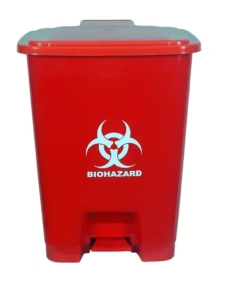
Purpose:
Collection of non-infectious, non-anatomical plastics that are contaminated but sterilizable and capable of being recycled.
What Goes Into Red Bags/Containers:
Contaminated Plastics:
- IV tubing, catheters
- Urine bags, enema bags
- Syringes (without needles)
- Gloves, masks, head-caps, shoe covers
- Blood bags after expiry (without blood residue)
Lab Disposables:
- Petridishes, Falcon tubes, microcentrifuge tubes (after disinfection)
- Autoclavable plastic pipettes
- Vacutainers (without needles)
Treatment & Disposal:
- Pre-treatment: Autoclaving / microwaving / hydroclaving
- Shredding into flakes
- Recycling via authorised plastic recyclers
Why Red?
Represents waste that is not destroyable but recoverable, promoting hospital sustainability.
3. White Category (Translucent) – Sharps Waste Container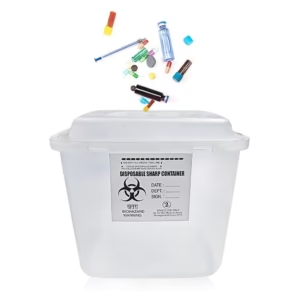
Purpose:
Safe containment of sharp objects that can puncture, cut, or cause percutaneous injury.
What Goes Into White Containers:
Sharps:
- Needles (used/unused)
- Scalpels, surgical blades
- Lancets
- Glass slides/coverslips (state-specific variations)
- Metallic chips and orthodontic wires (dental)
- Needle-tip of syringe after needle cutter
Critical Requirements:
- Puncture-proof, leak-proof, tamper-proof containers
- Must be rigid and sealed once 3/4th full
Treatment & Disposal:
- Autoclaving / dry heat sterilization
- Shredding or encapsulation
- Metal recovery or disposal in secured landfill
Why White?
Neutral color for sharps to avoid association with other waste categories and ensure immediate identification.
4. Blue Category – Glassware and Metallic Implants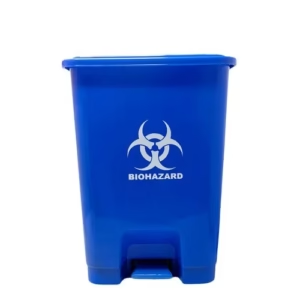
Purpose:
Segregation of breakable, reusable, or recyclable hard waste, particularly laboratory and pharmaceutical glassware.
What Goes Into Blue Containers (Cardboard boxes with blue marking):
Glass Waste:
- Glass vials
- Ampoules (non-hazardous residues)
- Broken or discarded laboratory glassware (beakers, test tubes)
- Reagent bottles
Metallic Waste:
- Implants (orthopedic plates, screws, prostheses)
- Dental amalgam capsules (requires pre-treatment if containing mercury)
Treatment & Disposal:
- Disinfection / autoclaving
- Recycling by authorised recyclers
- Mercury-containing waste → special mercury reclamation process
Why Blue?
Indicates recyclable non-plastic rigid material.
5. Black Category – Hazardous Chemical Waste / Pharmaceutical Waste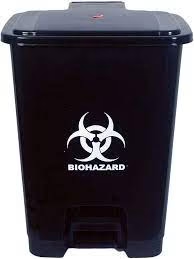
Note: Black category is used in many states for chemical/expired drug waste storage, although recent guidelines try to reduce its usage. Many hospitals still use black for heavy chemicals.
Purpose:
To store waste that cannot be incinerated due to toxic fumes, cannot be recycled, and is unsuitable for yellow bag incineration.
What Goes Into Black Containers:
Chemical Waste:
- Laboratory chemical reagents
- Solvents, acids, alkalis
- Fixatives (formalin)
- Disinfectants and expired laboratory reagents
Pharmaceutical Waste:
- Cytotoxic drugs (chemotherapy waste)
- Genotoxic materials
- Ampoules containing toxic chemicals
- Heavy metal waste (mercury thermometers, batteries)
Treatment & Disposal:
- Chemical neutralization
- Incineration at specialized hazardous waste facilities
- Secured landfilling
Why Black?
Represents non-infectious but chemically dangerous waste.
6. Green Category – General / Non-Biomedical Waste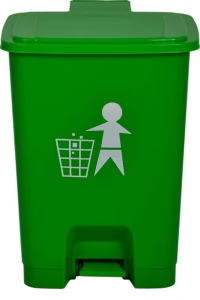
Purpose:
Segregation of non-contaminated, domestic-type waste produced inside healthcare settings.
What Goes Into Green Containers:
General Waste:
- Paper, cardboard
- Food leftovers
- Packaging material
- Non-blood stained cotton, gauze
- Plastic wrappers, cups, plates
- Office waste
Treatment & Disposal:
- Municipal waste handling
- Recycling
- Composting (for biodegradable waste)
Why Green?
Indicates safety and recyclability, ensuring waste is not over-classified as biomedical.
Workflow of Biomedical Waste Management
Below is a full hospital-level workflow incorporating regulatory, administrative, and operational components.
Generation
Occurs in:
-
OT, ICU, Wards
-
Labs (biochemistry, microbiology, hematology)
-
Radiology
-
Dialysis unit
-
Emergency
-
Blood bank
Segregation at Source (Critical Control Point)
This step determines the success of the entire BMW system.
Key requirements:
-
Must be done at the point of generation
-
No secondary segregation allowed
-
Use BIS-approved color-coded bins
-
Sharp containers must be closed when 3/4 full
Segregation errors cause:
-
Increased cost
-
Increased infection risk
-
Overloading of treatment plants
-
Legal non-compliance
Collection and Internal Movement
-
Waste should be collected every 2–4 hours depending on hospital size
-
Use closed trolleys with foot-operated lids
-
Trolleys must follow designated waste routes separate from patient areas
-
Avoid bag rupture and spillage
Intermediate Storage
-
Maximum holding time: 48 hours
-
Storage zone must have:
-
Impermeable flooring
-
Drainage system
-
CCTV surveillance
-
Restricted access
-
Biohazard signboard
-
Record register
-
Temperature Control:
-
Microbiological waste: 4–8°C (if not autoclaved immediately)
Barcoding and GPS Tracking
Mandatory since the BMW (Amendment) Rules 2018.
Benefits:
-
Prevents pilferage
-
Ensures traceability
-
Enables monitoring of waste flow
-
Reduces illegal disposal
External Transportation
-
Uses special BMW vehicles with:
-
GPS
-
Leak-proof containers
-
Disinfection protocol
-
Driver certification
-
Treatment Technologies
1. Autoclaving
-
-
121°C at 15 psi (30 min)
-
Kills bacteria, viruses, spores
-
Validation: Biological indicators (Bacillus stearothermophilus)
-
2. Hydroclave
-
-
Uses steam + mechanical agitation
-
Suitable for moisture-rich waste
-
3. Microwave Irradiation
-
-
Heats waste using electromagnetic energy
-
No incineration emissions
-
4. Incineration
-
-
Two-stage combustion:
-
Primary: 800–900°C
-
Secondary: 1000–1200°C
-
-
Used for yellow category and cytotoxic waste
-
Requires scrubbers, filters, and chimneys to remove pollutants
-
5. Plasma Pyrolysis
-
-
Converts waste into syngas at >5000°C
-
Environmental friendly
-
6. Chemical Disinfection
For liquid waste:
-
-
Sodium hypochlorite
-
Formaldehyde
-
Glutaraldehyde
-
7. Deep Burial
Only for rural areas with no access to CTFs.
Final Disposal
Depends on treatment method:
| Waste Type | Final Disposal |
|---|---|
| Autoclaved plastics | Shredding + Recycling |
| Incinerator ash | Secured landfill |
| Sharps | Encapsulation + Landfill |
| Glass waste | Recycling |
| Chemical waste | Neutralization + Disposal |
Biomedical Waste in Laboratories: Advanced Level
Biochemistry Lab Waste
-
Reagents containing acids, alkalis
-
Organic solvents
-
Heavy metal-containing reagents (copper, arsenic)
-
Disposable pipette tips
-
Blood/urine samples
Management:
-
Neutralization
-
Chemical deactivation
-
Autoclaving of contaminated plastics
Microbiology Lab Waste
-
Live cultures
-
Petri dishes
-
Biohazardous materials
Must undergo:
-
Autoclaving
-
Surface disinfection
-
High-level PPE usage
Histopathology Lab Waste
-
Xylene
-
Formalin
-
Tissue blocks
-
Staining reagents
Must follow:
-
Chemical waste protocols
-
Fume hood regulations
Liquid Biomedical Waste
Sources:
-
Diagnostic labs
-
Dialysis units
-
Operation theatres
-
Laundry
-
Radiology wash areas
Required Treatments:
-
Chlorination (0.5–1% available chlorine)
-
pH correction
-
Neutralization
-
Biological oxidation
-
CPCB standards final discharge
Occupational Health & Safety
Hazards:
-
Needle-stick injuries
-
Chemical burns
-
Aerosol exposure
-
Radiation exposure (in imaging centers)
Protection:
-
PPE
-
Biosafety cabinets
-
HBV vaccination
-
NSI protocol
-
Exposure register maintenance
Monitoring, Auditing & Quality Assurance
Hospitals must adopt a continuous monitoring system:
Internal Audits
-
Weekly BMW inspections
-
Color-code compliance checks
-
Waste composition analysis
External Audits
-
State Pollution Control Board inspections
-
NABH/NABL accreditation audits
Performance Indicators
-
Segregation efficiency (% non-infectious waste in red bags)
-
Per-capita waste generation rate
-
Sharps injury incidents
-
Timeliness of waste transport
Legal, Ethical & Environmental Framework
Legislative Requirements (India):
-
Bio-Medical Waste Management Rules, 2016
-
Supplementary Amendments 2018, 2019, 2022
-
CPCB guidelines
-
Environment Protection Act 1986
-
Water & Air (Prevention & Control of Pollution) Acts
Penalties for Non-compliance:
-
Heavy fines
-
Suspension of hospital license
-
Criminal charges
-
Environmental compensation fees
Innovations & Future Trends in Biomedical Waste Management
IoT-Enabled Smart Bins
-
Automatic segregation
-
Fill-level sensors
-
Real-time monitoring
RFID-Based Waste Tracking
-
Ensures complete traceability
AI-Based Waste Prediction Models
-
Helps optimize waste collection routes
-
Reduces costs
Green Hospital Concepts
-
Zero-waste systems
-
Solar-powered autoclaves
-
Waste-to-energy systems